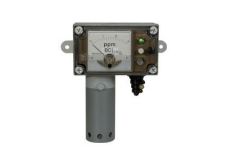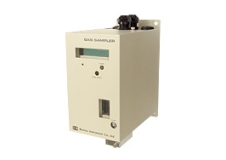Ozone Detection
Ozone with the formula O3, is an irritating, pale blue gas that is explosive and toxic, even at low concentrations. It occurs naturally in small amounts in the Earth’s stratosphere, where it absorbs solar ultraviolet radiation, which otherwise could cause severe damage to living organisms on the Earth’s surface. Ozone is a powerful oxidant and has many industrial and consumer applications related to oxidation. This same high oxidizing potential, however, causes ozone to damage mucous and respiratory tissues in animals, and also tissues in plants, above concentrations of about 0.1 ppm.
Ozone usually is manufactured by passing an electric discharge through a current of oxygen or dry air. The resulting mixtures of ozone and original gases are suitable for most industrial purposes, although purer ozone may be obtained from them by various methods; for example, upon liquefaction, an oxygen-ozone mixture separates into two layers, of which the denser one contains about 75 percent ozone. The extreme instability and reactivity of concentrated ozone makes its preparation both difficult and hazardous.
Applications
Because of its excellent disinfection and oxidation qualities, ozone is widely used for drinking water treatment. Ozone can be added at several points throughout the treatment system, such as during pre-oxidation, intermediate oxidation or final disinfection. Many pools, spas and hot tub manufacturers have added ozone as a secondary disinfection method, ensuring that customers’ equipment runs efficiently, and less chemical is required. The use of ozone in cooling towers has some great advantages, such as low maintenance costs and doesn’t require additional disinfectants.
The use of ozone in industrial laundries can potentially decrease washing temperature from 60 to 30 degrees and even use cold water in some cycles. This is because ozone leads to the production of oxygen which increases detergents potential in cleaning permitting to reduce the temperature. The reduction of hot water consumption will save costs and reduce carbon footprint. In addition, it will less damage your clothes.
Safety
Exposure to sustained and high levels or ozone gas can be highly irritating to the upper and lower respiratory tract. The characteristic odour is readily detectable at low concentrations (0.02 ppm to 0.05 ppm). Besides personal safety, ozone detectors are also used at electrical substations to provide an early warning of failure of internal electrical components.
Noventis provides a range of ozone detection solutions to keep your workplace safe. Our line of gas detection equipment includes portable sensors, single point sensors, replacement sensors, and calibration kits configured to meet your exact needs. View the product descriptions below to learn more or contact us to discuss your requirements.
Gas Specifications
- Gas Name: Ozone
- Formula: O3
- CAS No.: 10028-15-6
- TWA: 0.5 ppm
- LEL: Not Explosive
- Density relative to air: 1.66



